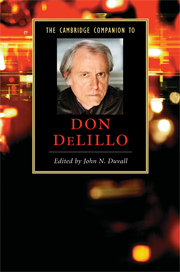Book contents
- Frontmatter
- Introduction: The power of history and the persistence of mystery
- PART I AESTHETIC AND CULTURAL INFLUENCES
- PART II EARLY FICTION
- PART III MAJOR NOVELS
- 6 White Noise
- 7 Libra
- 8 Underworld
- PART IV THEMES AND ISSUES
- Conclusion: Writing amid the ruins: 9/11 and Cosmopolis
- Select bibliography
- Guide to further reading
- Index
- Series List
8 - Underworld
from PART III - MAJOR NOVELS
Published online by Cambridge University Press: 28 June 2008
- Frontmatter
- Introduction: The power of history and the persistence of mystery
- PART I AESTHETIC AND CULTURAL INFLUENCES
- PART II EARLY FICTION
- PART III MAJOR NOVELS
- 6 White Noise
- 7 Libra
- 8 Underworld
- PART IV THEMES AND ISSUES
- Conclusion: Writing amid the ruins: 9/11 and Cosmopolis
- Select bibliography
- Guide to further reading
- Index
- Series List
Summary
Published in 1997, Underworld is widely regarded as Don DeLillo's major novel to date. In many ways it represents the culmination of DeLillo's novelistic career, though one must exercise caution in making such monumental statements about a living author who shows no signs of slowing down. We can say with certainty that Underworld brings together and extends themes that DeLillo has explored throughout his fiction: the relation between humans and technology; the contrast between history (and the subjects of history) conceived as a totality and history (and the subjects of history) conceived as multiple, fragmented, accidental; the excesses of consumer capitalism and its effects on individual life; the relation between language and the social order; the possibility of community amid the failure of politics; the contestation of secrecy and transparency in the contemporary world; and the world as waste and waste as art.
Underworld's range and discursive multiplicity suggest that it is an example of encyclopedic narrative, comparable to Robert Burton's Anatomy of Melancholy (1621), Lawrence Sterne's Tristram Shandy (1759), Herman Melville's Moby-Dick (1851), or more recently, Thomas Pynchon's Gravity's Rainbow (1973), a novel that anatomizes the West from World War II to the Nixon era, and to which DeLillo's multilayered portrayal of American life during the Cold War is often and easily compared. To be sure, Underworld takes the Cold War as its backdrop. The prologue, “The Triumph of Death,” published separately as “Pafko at the Wall” in the October 1992 issue of Harper's, is one of the most extraordinary openings in contemporary fiction.
- Type
- Chapter
- Information
- The Cambridge Companion to Don DeLillo , pp. 108 - 122Publisher: Cambridge University PressPrint publication year: 2008
- 3
- Cited by

